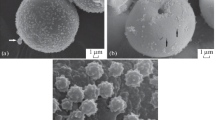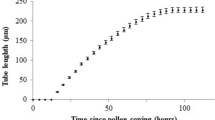Abstract
Pollen isolated from fresh and cold treated tobacco (Nicotiana tabacum L. ew. Wisconsin 38) flower buds were separated using aqueous polymer two-phase partitioning and analysed with respect to embryogenic capacity, peroxidase activity and isoperoxidase pattern. Pollen with embryogenic capacity from cold-treated flower buds were enriched in fractions with higher partitioning than those from fresh flower buds, but the amounts were the same. Cold led to a general increase in specific peroxidase activity in pollen fractions enriched in embryogenic pollen, and also to specific changes in the isoperoxidase pattern. Neutral peroxidase species (pI around 7) and alkaline species (pIs around 9) could be related to pollen fractions enriched in embryogenic pollen. The data agree with earlier data showing that the amount of pollen with the potential to form embryos is established at an early stage in flower development, whereas if they really do so depends on how they are pretreated, e.g. by cold treatments of the buds. The latter is also reflected by quantitative and qualitative differences in peroxidase.
Similar content being viewed by others
References
Bearden JCJr (1978) Quantitation of submicrogram quantities of protein by an improved protein-dye binding assay. Biochem. Biophys. Acta 553: 525–529
Bos ES, van der Doelen AA, van Rooy N & Schuurs AHWM (1981) 3,3′,5,5′-tetramethylbenzidine as an ames test negative chromogen for horse-radish peroxidase in enzyme-immunoassay. J. Immunoassay 2(3&4) 187–204
Catesson AM, Imberty A, Goldberg R & Czaninski Y (1986) Nature, localization and specificity of peroxidases involved in lignification processes. In: Grippin H, Penel C & Gaspar Th (Eds) Molecular and Physiological Aspects of Plant Peroxidases (pp 190–198). Imprimerie Nationale, Genéve
Cordewener J, Boij H, van der Zandt H, van Engelen F, van Kammen A & de Vries S (1991) Tunicamycin-inhibited carrot somatic embryogenesis can be restored by secreted cationic peroxidase isoenzymes. Planta 184: 478–486
Espelie KE, Franceschi VR & Kolattukudy PE (1986) Immunocytochemical localization and time course of appearance of an anionic peroxidase associted with suberization in would-healing potato tuber tissue. Plant Physiol. 36: 473–516
Hammerschmidt R, Nuckler E & Kue J (1982) Association of enhanced peroxidase activity with induced systemic resistance of cucumber to Colletotricum lagenatium. Physiol. Plant Pathol. 20: 73–82
Herberle-Bors E (1982) In vitro pollen embryogenesis in Nicotiana tabacum L. and its relation to pollen sterility, sex balance and floral induction of the pollen donor plants. Planta 156: 396–401
Heberle-Bors E (1985) In vitro haploid formation from pollen: a critical review. Theor. Appl. Genet. 71: 361–374
Heberle-Bors E (1989) Isolated pollen culture in tobacco: Plant reproductive development in a nutshell. Sex Plant Reprod. 2: 1–10
Horner M & Street HE (1978) Pollen dimorphism: Origin and significance in pollen plant formation by anther culture. Ann. Bot. 42: 763–771
Joersbo M, Andersen JM, Okkels FT & Rajagopal R (1989) Isoperoxidases as markers of somatic embryogenesis in carrot cell suspension cultures. Physiol. Plant. 76: 10–16
Lagrimini ML, Bradford S & Rothstein S (1990) Peroxidase-induced wilting in transgenic tobacco plants. Plant Cell 2 (1): 7–18
Lyons JM (1973) Chilling injury in plants. Annu. Rev. Plant Physiol. 24: 445–466
Mårtensson BK & Widell S (1987) Separation of precultred pollen from Nicotiana tabacum by aqueous polymer two-phase partition. Plant Cell Tiss. Org. Cult. 8: 27–35
Rao KV, Suprasanna P & Reddy GM (1990) Biochemical changes in embryogenic and non-embryogenic calli of Zea mays L. Plant Science 66: 127–130
Rashid A & Reinert J (1980) Selection of embryogenic pollen from cold-treated buds of Nicotiana tabacum var. Badischar Burley and their development into embryos in cultures. Protoplasma 150: 161–167
Sagwan RS & Camefort H (1978) Action d'un choc thérmique sur le contenu en acides aminés des anthérs et des grains de pollen embryogénes de Datura metal L. et du Nicotiana tabacum L. CR. Acad. Sci. Ser. D 287: 471–474
Sunderland N & Roberts M (1979) Cold-pretreatment of excised flower buds in float culture of tobacco anthers. Ann. Bot. 43: 405–414
Zársky LR & Tupy J (1987) Interference of pollen diffusable sustances with peroxidase catalysed reaction. Plant Science 52: 29–32
Author information
Authors and Affiliations
Rights and permissions
About this article
Cite this article
Mårtensson, B., Widell, S. Pollen from cold-treated Nicotiana tabacum buds: Embryogenic capacity, peroxidase activity and partitioning in aqueous two-phase systems. Plant Cell Tiss Organ Cult 35, 141–149 (1993). https://doi.org/10.1007/BF00032963
Received:
Accepted:
Issue Date:
DOI: https://doi.org/10.1007/BF00032963




